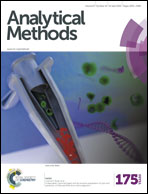Synthesis of new hybrid sorbent 2-mercaptobenzaldehyde SBA-15 and its application in solid phase extraction of Cd(ii) from water and food samples†
Abstract
In this paper, a new mesoporous hybrid material was fabricated by anchoring 2-mercaptobenzaldehyde (2MB) onto the surface of SBA-15. The adsorbent (2MB-SBA-15) was characterized by Fourier transform infrared spectroscopy (FT-IR), X-ray diffraction (XRD), transmission electron microscopy (TEM), scanning electron microscopy (SEM), nitrogen adsorption–desorption isotherm measurements and thermogravimetric analysis (TGA) and applied as a sorbent in the preconcentration of Cd(II) in water samples and food samples. The effect of various analytical parameters such as pH, dose of sorbent, amount of eluent, sample flow rate and interfering ions was investigated. The preconcentration capacity of the prepared material under optimized conditions for Cd(II) was 0.94 ± 0.01 mmol g−1. The Cd collected onto the sorbent was eluted out with 10 mL of 1 M HNO3 and determined by AAS. The LOD, LOQ and preconcentration factor of the present method were found to be 6.93 × 10−6, 1.21 × 10−5 mM and 100, respectively. The relative standard deviation for four preconcentration experiments was found to be ≤5%.


 Please wait while we load your content...
Please wait while we load your content...